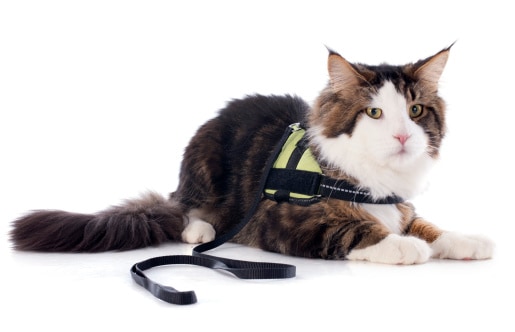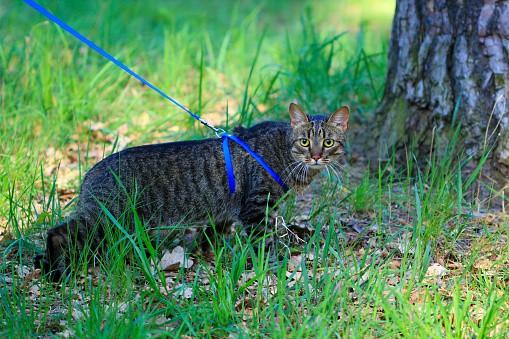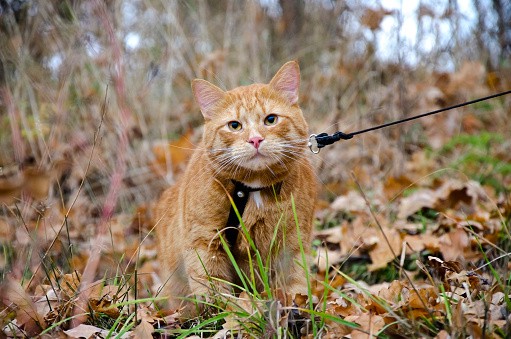For cat owners who love adventure, training your cat to walk on a leash can be a great way to enjoy the outdoors together. While it may seem like a daunting task, with a little patience and perseverance, most cats can learn to walk calmly on a leash.

While we can all agree that cats are safest from the dangers of predators, disease, and traffic when kept indoors, walking your cat on a harness and leash can be a wonderful way to let your feline companion enjoy a bit of outdoor time while ensuring his safety.
Taking your cat for walks can alleviate boredom (and the behavior problems associated with it) and is a great way to exercise your kitty and reduce obesity. It also comes in really handy for travel and trips to the veterinarian! The key is to start slowly and build up gradually to longer walks. It’s also important to choose the right type of leash and harness, which should be comfortable for your cat and allow them plenty of movement. With a little time and effort, you and your cat can enjoy many safe and fun adventures together.
Use A Harness Designed for Cats

This is especially important. There are thousands of harnesses on the market, but many fewer are designed specifically for a cat’s anatomy—which differs from dogs. You can choose from cat harnesses, walking jackets, or holsters. Look for those that have the leash attachment at the middle of the back, rather than at the neck, which is safer for your kitty. We use and recommend the Come With Me Kitty Harness and Bungee Leash by PetSafe.
Never attach a leash to a collar on your cat! Most cat collars have a breakaway buckle and if your cat pulls away, the buckle with open and your cat will be able to run away. Additionally, we recommend attaching an ID tag with your contact information to your cat’s harness, on the off-chance that you and your cat should become separated during a walk.
Start Leash Training Your Cat Indoors

Don’t strap the harness and leash on your cat and head straight outdoors – that’s a recipe for failure! In order for your cat to successfully walk on a leash, you’ll need to first get him used to wearing his harness. So, start indoors where he’s comfortable. Put the harness on your cat but don’t attach the leash yet. Immediately distract him with his favorite high-reward treats. Adjust the harness to fit properly. You should be able to fit two of your fingers between the harness and your kitty’s body. Leave the harness on for a few minutes a day for several days, rewarding your cat every time he’s wearing it. If he doesn’t mind wearing it, increase the amount of time it stays on.
Once your cat is comfortable wearing the harness, it’s time to attach the leash! Still inside your home, attach the leash and allow it to drag behind your cat. Remember to continue giving your cat treats or distract him with his favorite toys while he’s wearing the harness and leash. Repeat this for a few minutes a day for several days.
When your cat is used to the leash dragging behind him, then it’s time to pick up the leash. Hold it gently – don’t pull against it – and follow your cat as he walks around the house. Let your cat lead you, and praise and reward him. Practice this for a few days.
If you’re content with simply following your cat around where he wants to go, it’s now safe to proceed outdoors! Or, you can continue the training and encourage your cat to walk along with you.
How to Train Your Cat to Walk With You

Apply very gentle but consistent pressure on the leash, pulling in the direction you want your cat to go. When your cat finally takes a step toward you, reward him with a high-reward treat. He’ll also be rewarded with relief from the tension on the leash, which will reinforce the behavior. Remember, aversive training techniques do not work with cats. So, jerking and popping the leash will not work! In fact, it will only serve to scare your cat and undo any training you’ve done up to this point.
Pay Close Attention When You’re Outside

No doubt you’re aware of how differently even the most confident cat will act when she’s outside of her home. Cats who have never been outside will be nervous and easily startled, so start somewhere quiet. Let your kitty move at her own pace.
Pay attention to your cat’s body language and you’ll know if she’s scared or stressed. Look for flat ears, nervous tail twitching, meowing, and body low to the ground. When you notice these signs, try to figure out what’s making your cat so nervous and move to a better spot or end your outdoor adventure and try again another time. And, obviously, don’t let your cat lick or eat anything off the ground while you’re on a walk, and never leave her tied up outside unattended.
Final Words
Leash walking for cats is gaining more and more popularity these days, and that’s because it’s a safe alternative to letting our precious pets outside on their own. It provides them with much-needed environmental enrichment while keeping them out of harm’s way. If you’re going to be one of the thousands of cat parents who enjoy leash walking their kitties, just be sure your feline friend is up-to-date on vaccines and current on parasite prevention should you encounter any other critters on your walks. Most of all, have fun!
If you found this article helpful, pin it!








